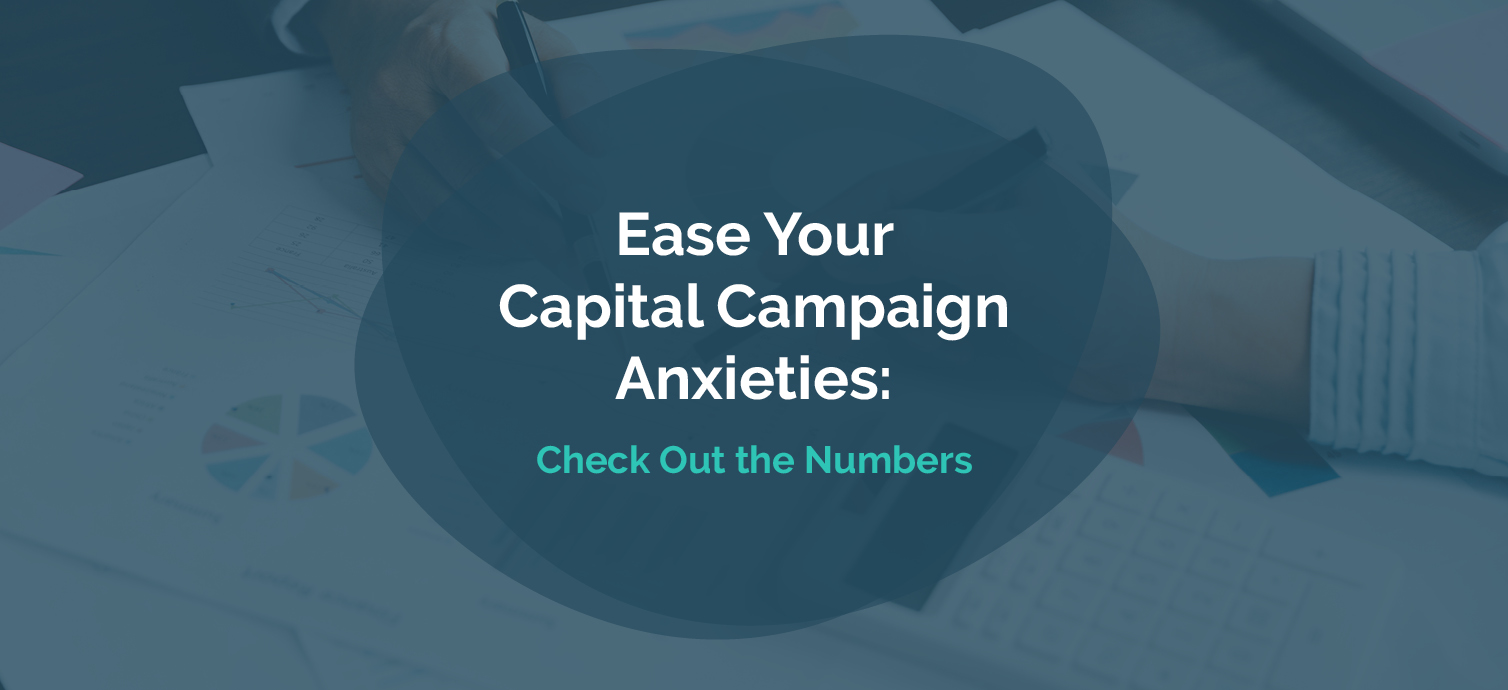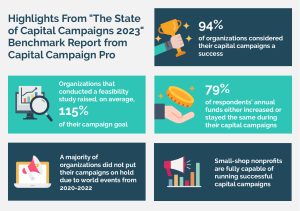
If your nonprofit is considering a capital campaign for the first time, you may have some concerns.
For instance, are your current plans for a building project or endowment investment effort feasible? Is your board engaged and ready to invest in your campaign? Do you have enough major donors to help reach your funding goal? What if the economy tanks while you’re in the middle of the campaign?
These are all normal worries—a capital campaign is no small undertaking, even for large organizations with loyal support bases. Plus, finding evidence of capital campaign success that isn’t just anecdotal or derived from one-off case studies can be difficult.
However, there’s no need to spiral! Thanks to a new research study, your organization can rest assured that capital campaign success is possible.
In early 2023, Capital Campaign Pro surveyed 276 nonprofits in the U.S. and Canada that were currently conducting campaigns or had recently completed one. Let’s dive into a few key findings. To get even more insights, you can get your own copy of Capital Campaign Pro’s research study.
Capital campaigns are overwhelmingly successful.
When asked if they considered their capital campaigns a success, a whopping 94% of survey respondents said yes. Furthermore, the average percentage of campaign goals raised was 108%, with the highest being 170% and the lowest being 75%.
The reason these organizations found this high degree of success was because of careful preparation and planning. Here’s a quick walkthrough of the pre-planning and planning steps to follow to set the stage for a successful campaign, all from Capital Campaign Pro’s capital campaign guide:
Pre-Planning Steps
The pre-planning stage provides an opportunity for you to develop a vision for your campaign, educate your stakeholders, and get assistance from an expert.
- Develop a working goal for the campaign based on the costs of its objectives.
- Create a draft of your case for support.
- Create a gift range chart that shows the number of gifts you need at each level.
- Put together a list of lead donors you have strong relationships with.
- Engage your top prospects in early conversations about the campaign to begin securing their buy-in.
- Educate your board members about the roles they’ll play in your campaign.
- Hire a capital campaign consultant or campaign advisor, or seek out do-it-yourself resources.
Planning Steps
The planning steps allow your nonprofit to confidently build out the framework for the capital campaign based on the work done in the pre-planning stage.
- Assemble a campaign planning committee.
- Conduct a feasibility study to test your plan and working goal.
- Adjust your plan based on the feasibility study results.
- Hire additional staff for the campaign (if needed).
- Create a campaign budget, timeline, policies, communication strategy, and donor recognition strategy.
- Recruit campaign chairs.
- Prepare to solicit early gifts from lead donors.
One of the most important steps is the feasibility study, conducted early in the planning stage. A feasibility study is your chance to determine whether your initial plans are realistic and possible for your organization or if they need adjusting.
Capital Campaign Pro’s research found that organizations that conducted a feasibility study raised, on average, 115% of their campaign goal (as opposed to 101% for the organizations that did not conduct a feasibility study). Additionally, 94% of these organizations strengthened their major donor relationships (versus 66% of organizations that did so but did not conduct a feasibility study).
A thoughtful feasibility study can make a world of difference to a nonprofit preparing for a capital campaign. Make the most of this opportunity by looking at your fundraising strategy with a critical eye, staying open to stakeholder feedback, and acting on suggestions for improvement.
Capital campaigns do not put your annual fund at risk.
Some nonprofits put off conducting a much-needed capital campaign because they fear that a campaign will undermine their annual fundraising efforts. After all, won’t donors get overwhelmed if you ask them to give generously to multiple campaigns?
According to the research, you have nothing to fear. Capital Campaign Pro’s study found that 79% of respondents’ annual funds either increased or stayed the same during their capital campaigns.
With the right strategies behind you, your loyal supporters will see and appreciate your outsized efforts to complete a special project and level up their giving and support accordingly.
Here are a few ideas for how you can communicate the special nature of your capital campaign to your supporters while still maintaining your annual fund:
- Write and share a compelling case for support, sharing the urgent need for your campaign and the expected impact and benefits for your organization’s beneficiaries and the larger community.
- Emphasize the one-time nature of your capital campaign, drawing on the fact that your campaign will fund a special project that is over and above your annual operations.
- Highlight the difference between your capital campaign and your annual fundraising campaign, letting your supporters see the importance of contributing to a special project and helping your nonprofit maintain its normal operations.
Above all, be clear and transparent as you launch into capital campaign mode. Continually communicating the difference between your capital campaign and your annual fundraising efforts—and providing updates on both initiatives—will be critical to securing support.
You can still have a successful campaign despite world events.
It’s no secret that the nonprofit sector has weathered some major upheavals recently, the most significant being the COVID-19 pandemic. Economic uncertainty and troubling political and social events have also taken their toll.
However, you can confidently move forward with a capital campaign despite what is going on in the world. The Capital Campaign Pro study found that most organizations did not put their campaigns on hold during the pandemic (73%) or due to economic uncertainty or recession fears (87%) between 2020 and 2022.
Even through tumultuous times, charity and nonprofit work are still important priorities for people. For many donors, these factors only make the work of their favorite nonprofits even more critical.
To be successful no matter the landscape you’re conducting your campaign in, keep these things in mind:
- Demonstrate a compelling need for your campaign using effective storytelling and communication strategies.
- Ensure your board members, leaders, corporate partners, and other key stakeholders are committed to seeing the campaign through.
- Find and develop relationships with qualified prospects.
- Make a thorough plan and stick to it (but don’t be afraid to pivot if needed).
When your organization is prepared, you can still be confident you’ll cross the capital campaign finish line, especially since these campaigns last several years—you’re bound to see some real-world turbulence during that time anyway.
Small-shop nonprofits are capable of planning and running successful campaigns.
You may think that your nonprofit is currently too small to conduct a successful capital campaign, even if you have a project in mind that could make a real difference to your cause.
The Capital Campaign Pro study debunks the myth that capital campaigns are out of reach for small shops. Here’s what their survey found about organizations that make $1 million or less in annual revenue:
- Their campaign goals were smaller, and they, on average, raised around $3.5 million.
- They had higher levels of major donor relationship building and fundraising strategy improvement.
- They tended to have more active executive directors and boards.
As you can see, smaller organizations have advantages when it comes to capital campaigning, especially regarding the relationships within your organization and the relationships you have with your donors.
Plus, if growing your organization is a long-term goal, a capital campaign is an excellent way to jumpstart that growth and increase your capacity to do more good. A campaign provides you with an opportunity to intentionally nurture and strengthen your relationships with your community and expand a specific aspect of your operations.
If the idea of a capital campaign makes you anxious, you’re not alone! But there is plenty of evidence that you can accomplish a successful capital campaign.
Use these insights from Capital Campaign Pro’s 2023 capital campaign benchmark study to quell your fears and start working toward launching your capital campaign. You can do this!
